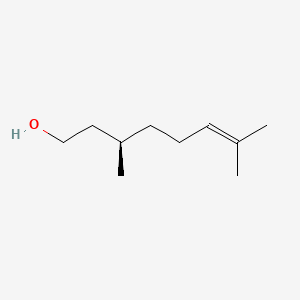| Authors | Title | Published | Journal | PubMed Link |
|---|---|---|---|---|
| Maia MF and Moore SJ | Plant-based insect repellents: a review of their efficacy, development and testing. | 2011 | Malar. J. | pmid:21411012 |
| Esmaeili A and Hashemi E | Biotransformation of myrcene by Pseudomonas aeruginosa. | 2011 | Chem Cent J | pmid:21609445 |
| Gonzalez-Audino P et al. | Comparative toxicity of oxygenated monoterpenoids in experimental hydroalcoholic lotions to permethrin-resistant adult head lice. | 2011 | Arch. Dermatol. Res. | pmid:21174108 |
| Lombard J and Moreira D | Early evolution of the biotin-dependent carboxylase family. | 2011 | BMC Evol. Biol. | pmid:21827699 |
| Battilana J et al. | Functional effect of grapevine 1-deoxy-D-xylulose 5-phosphate synthase substitution K284N on Muscat flavour formation. | 2011 | J. Exp. Bot. | pmid:21868399 |
| Weldon PJ et al. | Anointing chemicals and hematophagous arthropods: responses by ticks and mosquitoes to citrus (Rutaceae) peel exudates and monoterpene components. | 2011 | J. Chem. Ecol. | pmid:21409496 |
| Maurya RA et al. | Triple-channel microreactor for biphasic gas-liquid reactions: Photosensitized oxygenations. | 2011 | Beilstein J Org Chem | pmid:21915221 |
| Rose HL et al. | Comparison of eight methods for the extraction of Bacillus atrophaeus spore DNA from eleven common interferents and a common swab. | 2011 | PLoS ONE | pmid:21818364 |
| Goossens A | Contact-allergic reactions to cosmetics. | 2011 | J Allergy (Cairo) | pmid:21461388 |
| Gilpin S et al. | In vitro human skin penetration of geraniol and citronellol. | 2010 Jan-Feb | Dermatitis | pmid:20137738 |
| Sawabe Y et al. | Peroxisome proliferation activation receptor alpha modulation of Ca2+-regulated exocytosis via arachidonic acid in guinea-pig antral mucous cells. | 2010 | Exp. Physiol. | pmid:20472647 |
| Khanna S et al. | Nanomolar vitamin E alpha-tocotrienol inhibits glutamate-induced activation of phospholipase A2 and causes neuroprotection. | 2010 | J. Neurochem. | pmid:20028458 |
| Martin DM et al. | Functional annotation, genome organization and phylogeny of the grapevine (Vitis vinifera) terpene synthase gene family based on genome assembly, FLcDNA cloning, and enzyme assays. | 2010 | BMC Plant Biol. | pmid:20964856 |
| Geddawy A et al. | Mechanism underlying endothelium-dependent relaxation by 2-methylthio-ADP in monkey cerebral artery. | 2010 | J. Pharmacol. Sci. | pmid:20838025 |
| Reinhard J et al. | Honeybees learn odour mixtures via a selection of key odorants. | 2010 | PLoS ONE | pmid:20161714 |
| Ma L et al. | Evidence for de novo synthesis of lysophosphatidic acid in the spinal cord through phospholipase A2 and autotaxin in nerve injury-induced neuropathic pain. | 2010 | J. Pharmacol. Exp. Ther. | pmid:20123931 |
| Cronin H and Draelos ZD | Top 10 botanical ingredients in 2010 anti-aging creams. | 2010 | J Cosmet Dermatol | pmid:20883295 |
| Wu CY et al. | TLR4-dependent induction of vascular adhesion molecule-1 in rheumatoid arthritis synovial fibroblasts: Roles of cytosolic phospholipase A(2)alpha/cyclooxygenase-2. | 2010 | J. Cell. Physiol. | pmid:20112284 |
| Wu YZ et al. | Cytosolic phospholipase A2alpha mediates Pseudomonas aeruginosa LPS-induced airway constriction of CFTR -/- mice. | 2010 | Respir. Res. | pmid:20429932 |
| Ohkawara S et al. | Activation of the human transient receptor potential vanilloid subtype 1 by essential oils. | 2010 | Biol. Pharm. Bull. | pmid:20686244 |
beta-Citronellol
Beta-citronellol is a lipid of Prenol Lipids (PR) class. The involved functions are known as Glycolysis.
Cross Reference
Introduction
To understand associated biological information of beta-Citronellol, we collected biological information of abnormalities, associated pathways, cellular/molecular locations, biological functions, related genes/proteins, lipids and common seen animal/experimental models with organized paragraphs from literatures.
What diseases are associated with beta-Citronellol?
There are no associated biomedical information in the current reference collection.
No disease MeSH terms mapped to the current reference collection.
PubChem Associated disorders and diseases
What pathways are associated with beta-Citronellol
There are no associated biomedical information in the current reference collection.
PubChem Biomolecular Interactions and Pathways
Link to PubChem Biomolecular Interactions and PathwaysWhat cellular locations are associated with beta-Citronellol?
There are no associated biomedical information in the current reference collection.
What functions are associated with beta-Citronellol?
Related references are published most in these journals:
| Function | Cross reference | Weighted score | Related literatures |
|---|
What lipids are associated with beta-Citronellol?
There are no associated biomedical information in the current reference collection.
What genes are associated with beta-Citronellol?
There are no associated biomedical information in the current reference collection.
What common seen animal models are associated with beta-Citronellol?
There are no associated biomedical information in the current reference collection.
